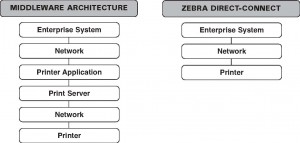Achieving PCI DSS v1.2 Compliance on Wireless Printers
Executive Summary
The challenges of meeting Payment Card Industry (PCI) security standards and the horror stories of failing to comply continue to grow. Security breaches at several major retailers have resulted in estimated costs of as high as $1 billion per retailer. The U.S. Identity Theft Protection Act has established fines of up to $11,000 per customer record for databases breaches. In fact, 14 percent of retailers have suffered a breach and only 28 percent of retailers are fully compliant with PCI requirements, according to the Retail Systems Alert Group 2006-2007 Retail Data Security study. Since that study, retailers are taking notice, and compliance rates are steadily increasing.
Merchants who do not comply are at risk for fines, higher processing fees and even the loss of card-processing privileges. PCI implementation costs are a major concern for many businesses, even if the cost of noncompliance is potentially so much higher. Consider that the cost of new preventative measures only averages 4 percent of the total breach cost, or $180,000.1
Amid these concerns, it is easy for retailers to lose sight of both the big picture and important details. PCI compliance is a major milestone, but it is only a means to an end of having secure processes, networks, data, devices, and peripherals. If a single networked device is non-compliant, the entire network and the retail information systems behind it are all non-compliant. This is why protecting peripherals is an essential, if somewhat overlooked, component of PCI compliance.
This white paper explains how PCI Data Security Standard (DSS) version 1.2 applies to wireless peripherals and presents options for including secure wireless printers in PCI-compliant wireless networks.
Bar Code Printing Options for Zebra Printers with Oracle WMS and MSCA
Executive Summary
Bar code output from the Oracle E-Business Suite® environment is traditionally accomplished through third-party software. However, Oracle’s Warehouse Management System (WMS) and Mobile Supply Chain Applications (MSCA) offer a new approach that can simplify bar code label printing. Oracle WMS and MSCA produce output in XML data streams, instead of a proprietary Oracle format. Zebra Technologies has embedded an XML parser in its XML-enabled printers, so output from Oracle WMS and MSCA is natively understood by the printer without additional middleware or server hardware. The graphic below illustrates the system architectures and components required for bar code output from Oracle WMS and MSCA using the middleware and Zebra direct connection approaches.
This white paper describes the middleware and direct-connect bar code printing options for Oracle WMS and MSCA, explains the system requirements for each, and provides guidance as to when each approach is best suited to particular environments.
The Motorola MC9500-K mobile computer: Re-defining field mobility — even in demanding environments
The challenge: the cost of a disconnected field workforce
The productivity of your field workforce is tied directly to the bottom line of the business — regardless of whether your field teams interact directly with your customers or are focused on maintenance of crucial business infrastructure such as pipelines and cable or telephone networks. If workers do not have access to everything they need to complete the service call on the first visit — from maintenance history to the parts database and equipment schematics — the cost of doing business increases and future sales may be lost. If timely maintenance is not scheduled or multiple truck rolls are required to complete a work order, not only is the cost of day-to-day operations increased, but also infrastructure downtime increases the cost of your products and services — reducing margins and customer satisfaction.
In order to protect the health of your business, your field workers need to operate at peak efficiency — yet they are out in the field, disconnected from the customer and equipment information required to act in real time. Paper forms must be used to collect information for a wide variety of transactions — and that information must then be entered into the computer upon return to the office. As a result, time is inserted into your business processes, creating lag times that reduce service levels, employee productivity, cash flow and overall profitability. The need to touch the data twice increases the opportunity for costly errors that again impact business efficiency. In addition, field workers are forced to phone the office for simple information requests — such as pricing, inventory and invoice information, directions and more — again injecting time and cost into business processes. And if cell phones, standalone GPS devices, cameras and more are utilized out in the field, the enterprise must purchase and manage multiple mobile devices per worker, increasing costs — and life for the field becomes more complex, reducing productivity.
The solution: a real-time field workforce for real business advantage
Field mobility addresses these issues by eliminating the gap between the voice and data networks in the office and your workers out in the field — with just a single device. With an integrated voice and data mobile computer in hand, your workers have what it takes to achieve maximum productivity — the tools required to automate every day processes as well as act in real time. End-to-end field service cycle times are reduced — out in the field as well as for the tangential processes inside your four walls.
The Mobile Warehouse: Staging and Shipping

Reduce Inaccurate Shipments
When it comes to staging and shipping, accuracy is everything.
In a mobile warehouse with real-time access to data, decision-making is easier and staging lanes and shipping docks operate smoothly.
Streamline the Staging and Shipping Process
By integrating mobile technology into your shipping process you can increase efficiencies, reduce errors and cut down on processing time. Utilizing a handheld mobile computer, you can bring staging, loading and dispatch transactions to real time — all while directing and confirming pallet movements. You even have real-time visibility of the docks and doors for timelier decision making.
In addition, our two-way digital radio systems give you the option of using voice or text commands to coordinate shipping. What’s more, the system’s Location Services application allows you to track and coordinate the movement of vehicles and employees at a busy loading dock.
Presenting the Mobile Warehouse from BarcodesInc and Motorola

In a fast-paced warehouse, visibility is everything. The more you can see across the enterprise, the more efficient your operation.
The key to enterprise-wide visibility lies in mobility.
In a mobile warehouse, everything and everyone moves seamlessly. By arming your workforce with cutting-edge wireless data management technology, inventory visibility and control is improved, everyone is connected with two-way voice and email, various manual tasks are automated, and overall productivity soars.
And that’s just the beginning.
In a mobile warehouse, the likelihood for human error is lower, floor personnel and office management can communicate in real-time, and repetitive, labor-intensive tasks like picking, put-away and receiving are completed in a fraction of the time. That’s because things like duplicate data-entry, manual checks and double checks, not to mention input errors, are completely eliminated.
And the benefits of mobility extend well beyond the four walls of your warehouse. With mobile computers and scanners, materials in transit are visible, goods on the dock or in the yard are kept moving, and assets can be tracked right from your warehouse floor.
In short, with a mobile warehouse solution from Motorola, all the bases are covered, with products designed to perform bar code scanning, image capture, RFID, voice communication and email. And it all works seamlessly with your Warehouse Management System.
It’s an intelligent way to keep warehouse productivity up and costs down.
And it’s just another way BarcodesInc and Motorola put Enterprise Mobility in the palm of your hand.
Mobile Healthcare: A prescription for error-proofing and increased productivity in the hospital
Applying mobility to improve patient safety and address staffing shortages
Mobility gives your healthcare workers the gift of time — time they can utilize to deliver higher quality patient care.
The Global Healthcare Dilemma
Hospitals all over the world are faced with a major issue — how to reduce the errors that take place every day — errors that are measured not just in dollars, but also in harm to patients. The problem is already sizable — the institute of medicine reported in a recent study that medication errors alone cause sickness, injury or death to at least 1.5 million patients in the U.S., at a conservative cost of $3.5 billion each year. And due to a combination of factors, the problem is growing at an alarming rate. Advancements in medicine are helping people live longer, resulting in a rapidly growing aging population — during the next 25 years, the over-65 population will increase five times faster than the under-65 segment, and over-85 is the fastest growing demographic. And as this aging population grows and places increased demands on the world’s healthcare systems, a worldwide nursing shortage has reached crisis proportions. due to an aging nursing workforce and fewer people choosing nursing as a career, 69 nations in every corner of the world are experiencing a shortage that affects the quality of healthcare, with a shortage of one million nurses in the U.S. alone predicted by the year 2020.
Understaffed nursing levels are already blamed for nearly one fourth of unanticipated events in hospitals that resulted in death, injury or permanent loss of function. How can today’s hospitals reduce errors when the current nursing shortage requires fewer nurses to cover more patients in less time? And what can hospitals do today to prepare for the impending increase in the nursing shortage in a world that will require more nursing services than ever?
RX: Mobility
Motorola offers powerful enterprise mobility solutions that place all the tools healthcare workers need in the literal palms of their hands — tools that not only provide the double and triple checks necessary to dramatically reduce errors, but also significantly improve productivity by eliminating manual paper-and-pen based, error-laden processes. Mobility arms healthcare workers with handheld mobile computers enabled with best-in-class partner applications and a wireless anywhere anytime connection to the hospital’s computer network. As a result, hospitals can dramatically improve the accuracy and efficiency of every day tasks — from medication administration and specimen collection to patient monitoring, medical rounds and more.
The Mobile Warehouse: Sorting

Increase the Overall Efficiency of Your Warehouse
If there’s one thing that can impact warehouse profitability, it’s your sorting processes.
A mobile technology solution from Motorola not only eliminates the problems associated with error-prone manual processes, it can increase the overall efficiency of your warehouse.
Gain Visibility over Operations
Solutions that utilize mobile computers and wireless technologies are changing the rules of warehouse sorting. By replacing paper accounting practices with automated ones, you can gain unprecedented control and visibility over your sorting operation.
The Mobile Warehouse: Returns

Check Returns Quickly and Accurately
Warehouse returns are one of those “little things” that can have a major impact on your warehouse operation.
In a Motorola mobile warehouse you can check returns quickly and accurately, re-label them right on the spot, decide whether or not to return them to stock, and eliminate the countless other problems associated with working at a fixed workstation.
The Mobile Warehouse: Receiving

Reduce Errors and Increase Accuracy
Receiving goods at the loading dock isn’t just labor-intensive; it can be error-intensive as well. Especially when you do things manually.
Simplify the Receiving Process
Receiving is much simpler in a Motorola mobile warehouse. Things you used to do by hand are now done using intelligent devices. You no longer have to worry about reading an unreadable label or punching the wrong number into your inventory system. The result: accuracy is increased. Costly errors and customer turnaround times are reduced.
Motorola’s mobile computers are rugged, multi-mode scanning devices with bar code, imaging and RFID capabilities. Combine them with wearable printers and you can print labels on the spot, reducing errors and increasing throughput.
To stay in touch with floor personnel in high-volume receiving areas, Motorola has a digital two-way radio system with a long battery life for clear and reliable communications.
The Mobile Warehouse: Put Away

Reduce Errors
For the typical warehouse operator, the put-away process can be a time-consuming, paper-based logistical nightmare.
In a mobile warehouse, put-away is more efficient. Errors are less likely. And productivity is taken to a whole new level.
Meet Customer Demands
The key is a real-time solution that utilizes wireless technologies in handheld and vehicle-mounted mobile computers, scanners and printers. Continue reading »






